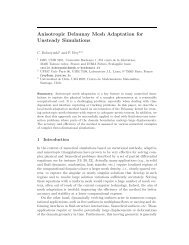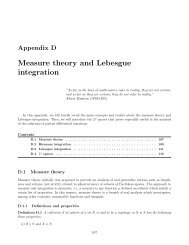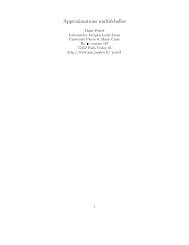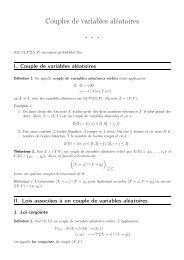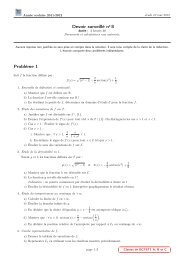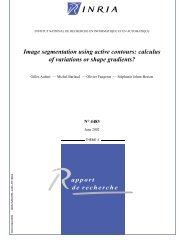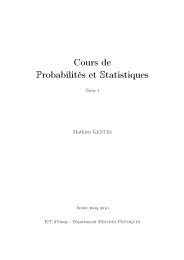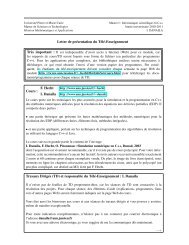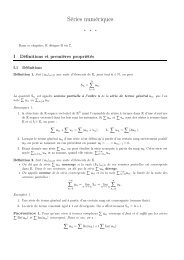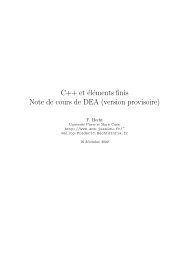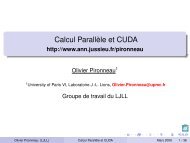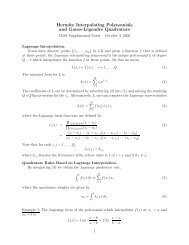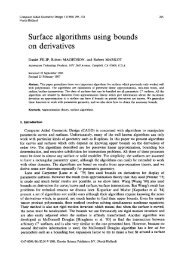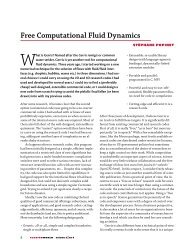pdf file
pdf file
pdf file
Create successful ePaper yourself
Turn your PDF publications into a flip-book with our unique Google optimized e-Paper software.
BOGOLIUBOV SPECTRUM OF INTERACTING BOSE GASES 9<br />
Remark 3. We shall always denote by C > 0 some (large) constant which<br />
depends only on T and w. Two C’s in the same line may refer to different<br />
constants.<br />
Theorem 1 (Bogoliubov Hamiltonian). If (A1)-(A2) hold true, then the<br />
operator H is symmetric and on the core domain (14) one has<br />
C −1 dΓ(h+1)−C ≤ H ≤ dΓ(h+C)+C. (16)<br />
Consequently, the form domain of its Friedrichs extension (still denoted by<br />
H) is the same as that of dΓ(1+h) on F+:<br />
∞�<br />
n=0 sym<br />
Moreover, we have the following spectral properties.<br />
n�<br />
D((h+1) 1/2 ). (17)<br />
(i) (Ground state and ground state energy). The Hamiltonian H has a<br />
unique ground state in F+. The ground state energy of H is strictly negative,<br />
except if w = 0, in which case we have infσ(H) = 0 (the ground state being<br />
the vacuum in F+).<br />
(ii) (Essential spectrum). The essential spectra of h and H are simultaneously<br />
empty or non empty, and we have in the latter case<br />
σess(H) = σ(H)+σess(h).<br />
Consequently, infσess(H)−infσ(H) = infσess(h) ≥ ηH > 0.<br />
(iii) (Lower spectrum). Assume that T = T (in this case u0 is a real-valued<br />
function and hence K1 = K2). If h + K1 has infinitely many eigenvalues<br />
below its essential spectrum, then H also has infinitely many eigenvalues<br />
below its essential spectrum.<br />
On the other hand, if T = T, K1 ≥ 0 and h has only finitely many eigenvalues<br />
below its essential spectrum, then H also has finitely many eigenvalues<br />
below its essential spectrum.<br />
We refer to Appendix A for a proof of Theorem 1 and further discussions.<br />
Remark 4. Note that since h+K1 ≥ ηH due to (7) and K1 is Hilbert-Schmidt,<br />
we always have infσess(h) ≥ ηH > 0.<br />
Remark 5. The reader should be cautious with the fact that, when w �= 0,<br />
even though K2 is a Hilbert-Schmidt operator on the one-body Hilbert space,<br />
the pairing term<br />
� �<br />
1<br />
2<br />
Ω<br />
Ω<br />
�<br />
K2(x,y)a ∗ (x)a ∗ �<br />
(y)+K2(x,y)a(x)a(y) dxdy<br />
is neither bounded on F+, or relatively compact with respect to dΓ(h). Indeed,<br />
when the essential spectrum of h is non empty, we have<br />
infσess(H) = infσ(H)+infσess(h) < infσess(h) = infσess(dΓ(h))<br />
due to Theorem 1, and hence H and dΓ(h) have different essential spectra.



